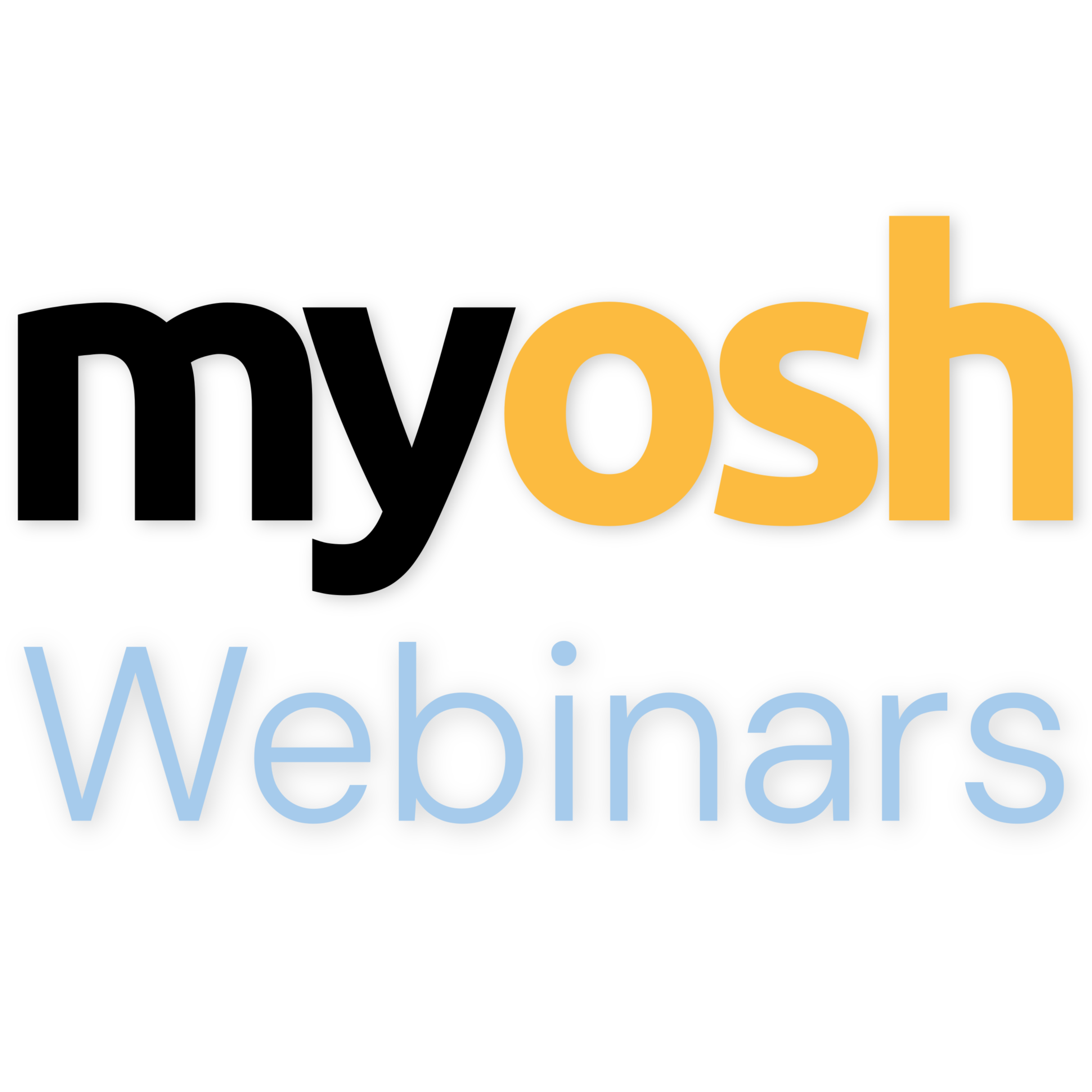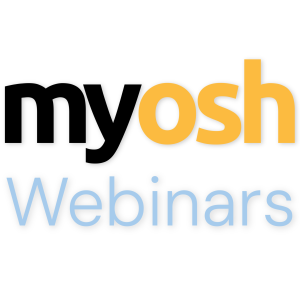
9.7K
Downloads
244
Episodes
myosh hosts regular HSEQ Industry Webinars. These podcasts include all of our webinars presented by leading industry experts and include topics such as Safety Differently, Mental Health, HSEQ Law, Leadership, Learning Teams, HOP (Human Organisational Performance), Chain of Responsibility, Safety Culture, Climate and much more.
Episodes

Thursday Aug 12, 2021
Thursday Aug 12, 2021
What’s covered?
In the second part of this webinar series, we will dive into the practical application of HOP at an organisational level, covering examples from organisations currently putting HOP into practice, and practical pathways for introducing HOP and Learning Teams.

Thursday Aug 12, 2021
Thursday Aug 12, 2021
What’s covered?
In the second part of this webinar series, we will dive into the practical application of HOP at an organisational level, covering examples from organisations currently putting HOP into practice, and practical pathways for introducing HOP and Learning Teams.

Thursday Aug 05, 2021
Thursday Aug 05, 2021
Presented by Andy Shone (CEO, Southpac Group)
What’s covered?
This webinar will provide an updated introduction to Human & Organisational Performance (HOP), including principles, terminology and key concepts. It will cover important topics including Blue Line vs Black Line (WAI vs WAD), asking better questions, and the importance of understanding and improving how everyday work happens.

Tuesday Aug 03, 2021
Prevention Is Not Enough
Tuesday Aug 03, 2021
Tuesday Aug 03, 2021
Presented by Vallorie Hodges and Fiona McCarthy
What’s covered?
A strong prevention bias in safety thinking doesn’t offer a robust understanding of the complexity of high consequence events. Despite the best risk assessments, procedures, and people, we simply cannot prevent all incidents. We must instead balance prevention efforts with capacity to respond and recover when things go badly. But how do we operationalise this in our organisations?
This session offers a model and the backstory of how we are using it as a simple visual framework to stimulate dialogue and promote learning, shared understanding, and safety differently language. The model is an adaptation of the bowtie… as a propeller. It includes preventive, operational and recovery elements placed in a dynamic mode, represented by turning blades – within a margin of manoeuvre sphere.
We use the model to highlight how prevention efforts deter threats, and to show how the capacity to respond to events may reduce the impact of events. But the real leverage comes when we conceptually shift from bowtie to propeller – the process becomes dynamic, demonstrating how learning creates a feedback loop to improve the entire system- including preventive, operational and response/recovery components.

Thursday Jul 22, 2021
LEAD4Safety: The Model and 4 Strategies
Thursday Jul 22, 2021
Thursday Jul 22, 2021
Presented by Dr Tristan Casey
What’s covered?
Numerous ideas and models abound regarding leadership and how it should be done to improve safety. In this complex and sometimes confusing space, it can be easy to get lost in the competing views of what ‘good’ safety leadership looks like.
LEAD4Safety is an innovative model of safety leadership, developed through active partnerships between safety science experts, the Queensland government, and industry. Where the LEAD4Safety model adds value is it integrates multiple theories about safety leadership and is also based on the idea that it is futile to search for a one size fits all approach to safety. Good safety management requires flexibility as well as stability; prevention of failure as well as promotion of success.
LEAD4Safety is an award-winning model that has been recognised by the National Safety Council of Australia via the coveted Pinnacle award in 2019, and has since been adopted by Workplace Health & Safety Queensland, the Electrical Safety Office, Teys Australia, WorkSafe Victoria, and many other diverse organisations in high-risk settings.
In this webinar, Dr Tristan Casey, safety leadership expert, will introduce the LEAD4Safety model and explain its science in easy-to-understand terms. Dr Casey will describe the four LEAD4Safety strategies and what example practices look like among successful safety leaders. The webinar will conclude with case studies around how LEAD4Safety has been applied by industry to achieve their safety performance goals.

Thursday Jul 15, 2021
How Good Leaders Create a Culture of Wellness: A Case Study from Construction
Thursday Jul 15, 2021
Thursday Jul 15, 2021
resented by Janet McCulloch (Strategic Consultant, Lysander)
What’s covered?
Historically, organisations have not had a significant focus on mental health and wellbeing within their workplace health and safety programs. With increasing awareness of the need to do something to take a proactive approach to preventing mental health injuries, HSE professionals are now faced with the question, “What works?”
An Integrated Approach to Wellness is a program developed to change workplace cultures and leadership practices in response to alarming findings in the 2018 Downey-Swinburne report. The report exposed the levels of depression, anxiety and stress in the construction industry exceeded Australian population norms by more than 37 per cent and were twice that of comparison industries, highlighting the need for industry-endorsed cultural change.
Using the pilot program undertaken on the Mordialloc Freeway Joint Venture as case study, this presentation outlines the key elements that need to co-exist in any Wellbeing program in order to optimise results. And the results on the Mordialloc Freeway project are fascinating to see.

Thursday Jul 01, 2021
The Story of the Lopsided Critical Risk Bowtie
Thursday Jul 01, 2021
Thursday Jul 01, 2021
Presented by Mark McLaren (Art of Work)
What’s covered?
An enormous amount of time and energy is rightfully invested in understanding what causes and subsequently prevents a life-changing injury or a fatality from happening in the workplace.
This genuine pursuit can inadvertently contribute to some unintended outcomes. The bid to stop the unwanted event can lull an organisation into a false sense of confidence. It is easy to become imbued with misplaced confidence that the designed and assessed preventive Critical Controls will reduce the likelihood of something going wrong to almost zero.
This overconfidence effect is a well-established bias. It occurs when a person’s subjective confidence in their judgements is greater than the objective accuracy of their judgements. This overconfidence bias can lead to a misjudgement of the likelihood or probability of something happening. In this case, the belief becomes one of, “now everything has been thought of and put in place it cannot happen.” The initial reaction to such a bold statement is that we don’t believe this to be true; we know it can still happen, albeit it is extremely unlikely to happen.
Well here is a simple test. Q1. How many mitigating controls sit on the right-hand side of your organisation’s Bowties, and Q2. If the loss of control event occurred would those controls prevent a serious injury or fatality?
So maybe a way of righting the lopsided Bowtie is not to jettison the controls on the left but to ask a different type of question. If the loss of control event happens and the damaging energy is released, such as mechanical, electrical, or gravitational, how will the damaging energy be contained, distanced or deflected so it does not cause a serious injury or fatality? In the upcoming webinar, the question of how to design better mitigating Critical Controls will be explored further.

Thursday Jun 24, 2021
Running Effective Pre-Start Meetings
Thursday Jun 24, 2021
Thursday Jun 24, 2021
Presented by Anthony Gibbs (CEO, Sentis)
What’s covered?
The importance of pre-starts and safety briefings should not be underestimated. When run effectively, they encourage two-way communication about safety hazards and controls, provide an open forum to discuss lessons learned, and highlight challenges and opportunities for improvement. But the unfortunate reality is that most pre-starts are seen as a ‘tick and flick’ activity, with little engagement or input from the teams on the frontline.
This webinar is key whether you’re a senior manager looking to support your leaders, on the frontline seeking to inspire your team to take safety seriously, or just curious to know what good looks like.

Thursday Jun 17, 2021
Thursday Jun 17, 2021
What’s covered?
Join Greencap, Risk & Safety Management specialists, in a presentation on key areas to focus on for the incoming 1 July General Environmental Duty (GED), covering what is changing, and what you can do to be prepared. Tips on how your business can stay ahead of the changes, avoid enforcement actions, and come out on top.

Thursday Jun 10, 2021
From Reacting to Learning – The Next Step in Organisational Effectiveness
Thursday Jun 10, 2021
Thursday Jun 10, 2021
Presented by Andy Shone (CEO, Southpac Group)
What’s covered?
What gets measured gets done, or so we believe! Today many organisations are driven by KPI’s and dashboards. The result of this often means that we focus on efficiency, getting stuff done quickly, as opposed to being thorough, i.e. being effective. This mindset appears to be increasingly driving the familiar routine;
-
- Deadlines are imposed for close out of the identified issues.
- Dashboards and reports drive action.
- Quick fixes ensue.
- Problems recur.
The result of all of this in the worst-case scenario is that Management Systems become a convenient mechanism for managing administrative work (safety work) without affecting the safety of work.
Einstein is reported to have said that if he only had one hour to solve a problem, he would spend 55 minutes defining the problem and the remaining 5 minutes solving it routinely. His focus was one on learning and understanding the true nature of the problem as opposed to gaining a superficial understanding and immediately instigating a fix.
Organisations need to move towards approaches that are more focused on learning and understanding. Approaches that accept the inherent complexity of the modern workplace, and in turn take systemic action to improve performance rather than falling back on simple explanations and familiar fixes.
Human and Organisational Performance (HOP) is an approach or philosophy that focuses on building an understanding of how organisations and people work together with the aim of enhancing performance. Looking at performance holistically includes all potential outcomes including safety, quality, productivity and efficiency.
The learning team method is focused on taking the time to truly understand, with the aid of frontline personnel, how work is happening and the best way to make it better.
